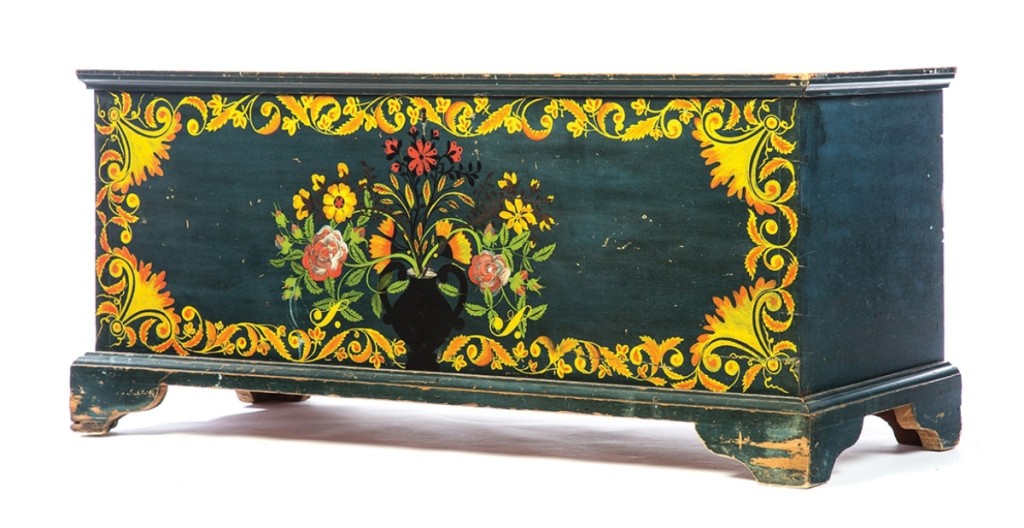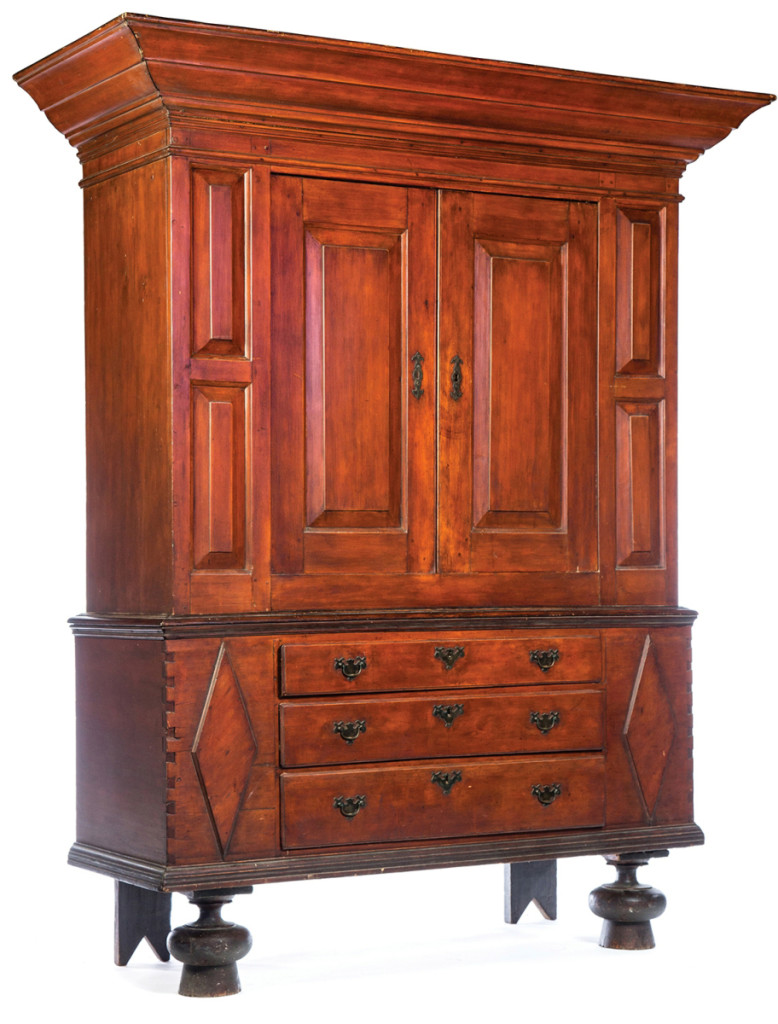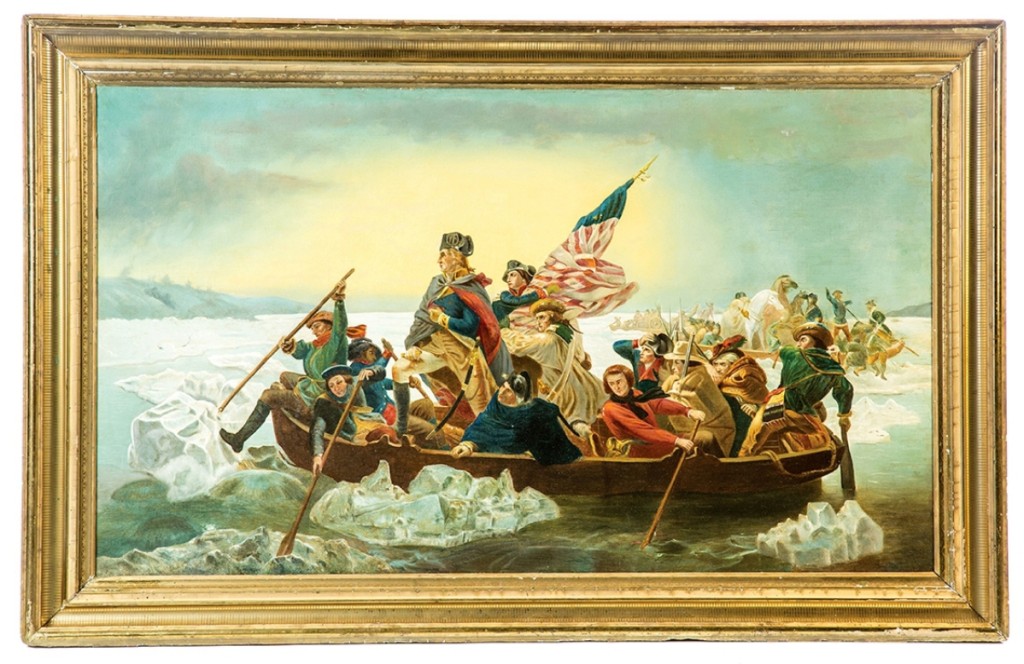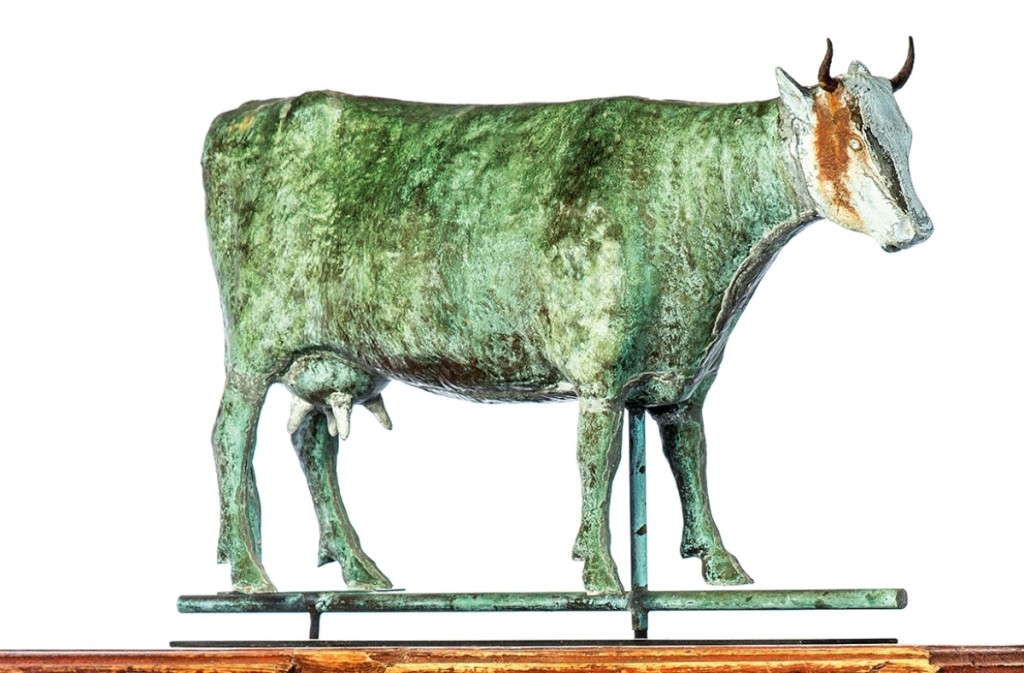
Offered as the first lot on Saturday morning, a Schoharie County, N.Y., pine painted blanket chest was also the top lot of the day. The first quarter Nineteenth Century chest with an original blue painted field and flowers in seven different colors, ex Peter Tillou, sold at $7,800.
Review by Anne Kugielsky, Photos Courtesy of Garth’s
COLUMBUS, OHIO – There was no snow in Columbus on January 18 and 19 and bidders responded by filling the auction galleries at Garth’s for the company’s Americana, Folk Art and Textiles sale. With day one featuring the 30-year collection of a gentleman from New York State that included painted furniture, pottery and folk art, and day two folk art and textiles from the collection of two sisters from Washington, DC, the sell-through rate was 98 percent by lot according to chief executive officer and principal auctioneer, Richard “Jeff” Jeffers.
“Overall I see some upward movement in price for furniture and folk art; look at corner cupboards, we had four or five nice examples, with good proportion, architectural form and surface. And they did well. The prices on day one tell the story, with good prices for high quality.”
For example, an American corner cupboard, first half of the Nineteenth Century, offered early in the day, sold for $4,125, above its $1,5/2,200 estimate for a poplar cupboard with its original red paint exterior and blue interior. It featured 12 panes on top and a base with inset molded panels and scroll cutout feet with spurs; standing 87½ inches high (7 feet 3½ inches), “there is just so much value for buyers who are willing to look,” Jeffers said.
An early Nineteenth Century pine New England cupboard also sold overestimate. The flatwall cupboard, 80 inches high with a door-over-drawer-over-door arrangement and original painted yellow surface had shelves inside and an overall worn but attractive surface. Coming to the block with a $900-$1,200 estimate, it sold on the phone at $3,360.
Leading the two-day auction was the first lot to cross the block: a Schoharie County, N.Y., decorated blanket chest with impeccable provenance that “retained its bright blue painted field with seven-color decoration of flowers that reached up into the trim decoration, unusual,” Jeffers said. Estimated at $4/6,000, the late Eighteenth or early Nineteenth Century dovetailed case with square nails, 19½ inches high by 42¼ inches wide by 17½-inch-deep chest (ex Peter Tillou) sold to an East Coast dealer for $7,800.

An Eighteenth Century Long Island, N.Y., gumwood kas with a red wash and ebonized original feet, ex Philip Bradley (Pennsylvania), sold at $5,880.
Folk art was also strong throughout the sale. A circa 1810 unsigned Ohio portrait of a man in an original red frame with corner blocks was of a well-dressed gentleman. Jeffers said, “you’d like to have him hanging on the wall, with his marvelous cartoonish face, he’s a good-looking guy.” Purportedly the sitter was Ebenezer Zane (1747-1811), the founder of Lancaster, Ohio, and the provenance included ex Robbins Hunter (Ohio), ex Clark Garrett (Ohio), ex David Good (Ohio). The 23¼-by-19½-inch oil on canvas sold after strong bidding from the gallery and across platforms, at $5,520 ($2,5/4,000).
“Our location [Columbus, Ohio] makes it easy for interested buyers to come here. We also have a lot of absentee bidders, including those who place a bid for us to execute, phone bidders live and left bids. I’d say the majority of our sales are absentee,” Jeffers said.
A fabulous folk art carved stag head drove the form to another level, Jeffers said. From the Upper Peninsula of Michigan, the third quarter Nineteenth Century wall mounted head with its original polychrome paint and real antlers still sporting some hide, came up with a $600/900 estimate; the 32-inch-high head sold to a collector at $3,060.
Then a wonderful American decorated gameboard found in New England sold above its $3,000 high estimate at $4,680. The late Nineteenth Century single board checkerboard had original paint with flourishes on the edges.
Weathervanes are the quintessential example of folk art, and there were several in the New York gentleman’s collection. A large (27 inches high) copper quill weathervane, late Nineteenth Century, with a verdigris patina, sold at just about its high estimate at $3,360; and another late Nineteenth Century vane, a full-bodied copper cow with a cast zinc and iron head, 23 inches high and 35 inches long (including the base), by Harris & Co., Boston, sold within estimate at $5,040.
A copper apothecary mortar and pestle trade sign with original sizing under the original gold leaf, purchased in Vermont, sold at $3,600. A rare large size from the second-half of the Nineteenth Century, the sign is 21 inches high.

A well-done early copy after the 1851 original version in the Metropolitan Museum of Art, “Washington Crossing The Delaware,” after Emanuel Leutze (Germany/New York City/Washington DC, 1816-1868), was unsigned and realized $4,800.
Rounding out the top lots of day one were a Connecticut apothecary, first half Nineteenth Century, that brought $5,750. The one-piece pine, open top apothecary in its original red painted surface had 36 dovetailed drawers and provenance to John Keith Russel (New York). A circa 1730-40 Massachusetts tavern table in maple had an old surface and molded apron on Queen Anne ball feet. With early nails present on top, it went to $4,200; an early wall cupboard with Shaker attribution sold at $3,720; a New Jersey cupboard, from Hackensack, late Eighteenth or early Nineteenth Century, a two-piece corner cupboard with arched door, double inset panel doors, carved shells and star bursts sold at $4,200 for an attractive grain-painted yellow over the original red.
Selling at $5,880 – a good buy said Jeffers – was an Eighteenth Century Long Island, N.Y., gumwood kas with a red wash and ebonized feet. The dovetailed case with original feet was constructed with rosehead nails and was ex Philip Bradley (Pennsylvania).
On Sunday, the collection of two Washington, DC, sisters had lots with a slightly different focus. The one surviving sister was not the biggest collector, but they both had a passion for folk art and textiles that made them smile. The collection was put together, Jeffers said, with love, for rarity and color – if the item was not “perfect” that was okay. This collecting attitude appealed to bidders who responded with enthusiasm.
Fine art, not all from the Washington sisters’ collection, was offered during the second day. A late Nineteenth Century oil on canvas after Emanuel Leutze (Germany/New York City/Washington, D.C., 1816-1868), of “Washington Crossing The Delaware,” realized $4,800. The unsigned but well-done early copy after the 1851 original version in the Metropolitan Museum of Art showed some restoration. Two works by Pennsylvania artist Walter Emerson Baum (1884-1956) crossed the block. The cover lot was sold on day one – a Pennsylvania winter scene of Green Street, Sellersville, Penn., was signed and dated 1917, and sold at $3,840. On day two, Baum’s autumn landscape with a blue house, a 24-by-30-inch oil on artist board, sold at $2,280.
A portrait of George Edwards by Nathaniel Lakeman (Massachusetts, b 1756) sold for $2,520. The 20-by-16¾-inch oil on wooden board of a young man wearing a coat with brass buttons, seated in an arrowback chair was labeled on the back “George Edwards Painted by N. Lakeman, Salem, June 1828, No. 1_8.” An additional exhibition tag from the Mattatuck Historical Society, Waterbury, Connecticut, read “Exhibition of American Primitives.”

This Harris & Co., Boston, late Nineteenth Century full-bodied copper cow with cast zinc and iron head weathervane sold within estimate at $5,040.
Textile highlights spanned samplers and quilts with most selling above estimates. A Friendship quilt from the Swank and Black families of Somerset, Penn., where they were in the stoneware business together, dated 1891, had a $400 to $800 estimate. The pattern showed a house, tulips, geometric shapes and the names Black, J.A. Ditmer, initials and others were embroidered in the 62-by-70-inch quilt that sold for $3,240.
A late Nineteenth/early Twentieth Century American Crazy quilt, pieced with animals and birds of assorted fabric, and several are stuffed, also had a modest, $900-$1,200 estimate but sold at $2,400.
An English sampler, estimated at $400/800, in a square, 16¼ by 16¼ inches, and a bird’s-eye maple frame, was signed, “Eliza Gravner, Aged 12 years, Halvergate School.” The silk on linen alphabet in a pyramid with verse and birds went to $2,750.
A tall case clock that had been sold by Garth’s 30 years ago (October 1990) to a private collector/client, returned on January 19. The early Nineteenth Century Western Pennsylvania Hepplewhite inlaid tall case clock in cherry showed cutout feet and a scrolled base with curly walnut medallion and cove molding. It sold at $3,375, just above its high estimate, and Jeffers said, “I was pleased – considering the current market for unpainted [furniture] – that it sold as strong as it did. Inlaid and regional were the driving forces. It is going to another private collector.”
Another favorite for collectors are powder horns, especially early and decorated. Garth’s offered one attributed to Timothy Tansel (Indiana, 1810-1852), with a scratch carved date of 1821. It had a large engraved eagle with an American shield and banner and the partial image of a hunter shooting a deer. It sold just above estimate at $2,640.
An American engraved horn with “James Smith, August 1, 1816,” had a thin-necked eagle with shield, fish, trees, dogs, a whale and whaling ship and was initialed “J.M.” It sold at $2,000, well above its $600/900 estimate, which was set due to a repair on the finial.
The Washington, DC, sisters had a large assortment of bandboxes and other folksy boxes, bigger and with scarce images, which bidders found attractive. One mid-Nineteenth Century oval cardboard box had block printed wallpaper of white squirrels on a blue ground. It was lined with an 1831 newspaper mentioning Wilmington. Estimated at $600/900, the 10¾-inch-high-by-18-inch-long bandbox sold for $1,875.
“It is important for people to feel they have a chance to win a lot all the way to the gavel. We need people to be engaged. One man called about a painting, unsure if the color would go well with his living room. So I suggested he use an app on his phone and take a picture of the spot in his house and drop the painting into it – he did and he bought it over the phone.”
Garth’s February 22 auction of Asian, continental, decorative and fine arts will include some “wonderful fine art and silver,” Jeffers concluded.
Prices, with buyer’s premium, as reported by the auction house. For further information, 740-362-4771 or www.garths.com.































